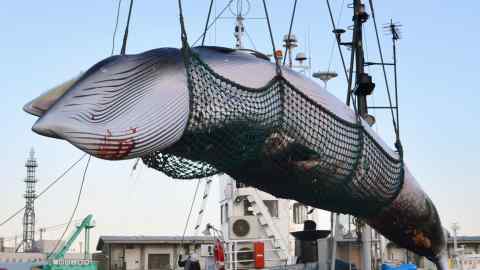[ad_1]
Hideki Tokoro, the last and only hope of Japan’s commercial whaling industry, wears a light-blue suit, a patterned blue shirt, a tie with whales on it and a large whale tie pin.
A self-made accountant who founded his own firm, Tokoro was brought in last year to run Kyodo Senpaku after working on a previous restructuring. The company owns and operates Japan’s only long-range whaling vessel — the Nisshin Maru — and dominates the controversial industry.
With Japan now withdrawing subsidies from whalers, Tokoro is on a mission to make Kyodo Senpaku turn a profit. His success or failure is likely to determine whether Japan remains a whaling nation or not.
“We’re now engaging in heavy promotional activity,†he says, in a rare interview with the Financial Times. “We need to get this shrinking market back on the increase.â€
The commercial challenge Tokoro has taken on shows the profound crisis triggered in his industry by Japan’s 2019 withdrawal from the International Whaling Commission, the global regulatory body, and resumption of whaling within its exclusive economic zone.
Researchers with harpoons
As an IWC member, Japan had agreed to abide by the organisation’s catch
quotas — which, since 1986, have been set at zero for commercial whaling. Japan got round this moratorium via a loophole in the IWC’s founding convention, which permits whales to be killed “for purposes of scientific researchâ€, with quotas determined by individual governments. The resulting “research whaling†programme was bitterly opposed by conservationists and other IWC members.
Ultimately Japan grew tired both of the IWC’s refusal to countenance a revival of commercial whaling, and of the expensive subsidies for research whaling. Pushed by powerful politicians from its whaling heartlands, Tokyo chose to leave the IWC, avoid international waters and let the industry sink or swim on its own commercial merits.
Kyodo Senpaku now has a government-set quota of 1,550 tonnes, which must be caught inside Japan’s exclusive economic zone — less than the 2,400 tonnes previously permitted, and comprising less commercially attractive species.
“Initially, everyone was excited to restart commercial whaling, and then the reality hit that the allowable catch was reduced,†Tokoro says.
Traditionally, whale is regarded in Japan not as a delicacy but as a source of cheap protein. It was widely used in school dinners during the 1950s and 1960s and still has that image.
Tokoro, who insists that whaling is an ecological positive, wants to rebuild consumer demand and finance a replacement for the Nisshin Maru, which is nearing the end of its life.

“Our targets are wealthy people and the young. The older Japanese people are, the more they regard whale as a low-level food,†he says.
Tokoro has teamed up with an Italian restaurant to produce whale haute cuisine. Talking in the office of his accountancy business, he shows a promotional CD of karaoke tunes and produces a tub of whale ice-cream to try. Made from 30 per cent whale oil, it is sorbet-like, with a slightly unpalatable citrus flavour.
Economic realities
Tokoro’s ebullience masks a grim financial situation. Sales fell from ¥3bn ($27m) in the 2018 financial year to ¥2.6bn ($24m) in 2020 as the price of whale fell from ¥1,200 ($11) per kilogramme to around ¥800, before picking up again more recently.
Kyodo Senpaku makes a large operating loss. Until last year, it received a ¥1.3bn annual subsidy, which has now been replaced by ¥1bn in government loans for each of the next three years. From 2024, it must survive on its own resources, all while financing a new ship that Tokoro expects to cost ¥6bn.
Tokoro is scornful of change-averse bureaucrats and of Japan’s coastal whalers, such as those who carry out the infamous Taiji dolphin hunt. “We’re aiming to be self-sufficient but the land-based whalers can’t possibly do it,†he says, because of their low sales and high costs.
Anti-whaling groups argue that hunting the marine mammals is both cruel and ecologically unsustainable. Governments such as the UK and Australia oppose whaling, and have blocked any attempt to lift the IWC moratorium.
Tokoro argues the opposite: that failure to hunt whales is unsustainable. He says whale numbers have been growing by 4 per cent a year since the moratorium began and claims they are putting pressure on fish stocks. “In the future, if we plan to catch fish then we’ll have to hunt whales,†he says.
More stories from this report
Joji Morishita, a professor at the Tokyo University of Marine Science and Technology and Japan’s last commissioner at the IWC before it withdrew, says there is little evidence to support Tokoro’s theory. But he adds that Japan’s quotas are based on strict IWC calculations to ensure sustainability, and that current levels of whaling have little impact on whale populations.
The switch to whaling only in Japan’s exclusive economic zone has reduced international pressure, and Japan’s coast guard can prevent campaigners carrying out direct action against whalers in local waters.
Tokoro is defiant towards activists who regard whales as different from other animals killed for food. “To the people who say that whales are cute like pandas, so you shouldn’t eat them, all we can say is ‘fine’,†he says.
But the greater threat to Kyodo Senpaku is the changing tastes of the Japanese public and the short remaining lifespan of the Nisshin Maru, without which it will in effect be out of business.
Unless Tokoro can revive the nation’s appetite for whale, the industry is likely to die not from international outrage, but from Japanese indifference.
Â
[ad_2]
Source link





